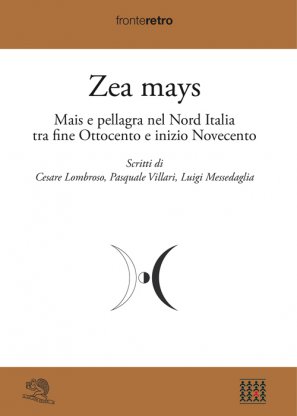
Zea Mays: Corn and Pellagra in Northern Italia in the 19th and 20th Centuries
Written by Cesare Lombroso, Pasquale Villari, and Luigi Messedaglia
Pellagra, by now an obsolete disease, once long-afflicted Italy and claimed thousands of victims. This depressing saga is connected to the people’s dependence on corn (Zea mays L.), the grain originating in the Americas which eventually became a staple in the Lombard and Venetian fields of Northern Italy.
Between the end of the 19th and beginning of the 20th century, the debate on pellagra reached its peak, encompassing every aspect of the disease which had become the scourge of farmlife, and often assuming the tones of a bitter ideological battle.
The volume opens with pages of a social report, written in the form of a “dialogue” between the personifications of Pellagra and Liberty and published in 1885 in the periodical Il Pellagroso.
Thus begins the account of Cesare Lombroso who, noted for his studies on criminal anthropology, was also interested in pellagra and became a champion of the “Zea Toxicant” theory and of the theory of the inheritance of the disease. His essay La pellagra ed il maiz in Italia is rich not only in data, but also in notes on his contemporary environment which show that despite being contested by his conemporaries, he pursued his dedication ,to the art of observation and experimentation.
In La pellagra e i contadini nella provincia di Mantova, the historian Pasquale Villari summarizes and comments on the results of an inquiry by a Mantovian Commission in 1878: a case which was symbolic of the social misery which was at the foundations both of the disease and of the proposals given to fight it.
Luigi Messedaglia closes the volume with Mais e pellagra: un dramma di vita rurale, in which he synthesizes two centuries of studies, discussions, and counter-measures until the disappearance of the disease, while also leaving space for an analysis of the unpredictable effects of the First World War on the history of the disease.
Authors
Cesare Lombroso
(Verona, 1835-Turin, 1909), psychiatrist, anthropologist, and criminologist. He taught at the University of Pavia, his alma mater, and at the University of Turin, where he was also prison doctor and councilman of the Socialist Party. He was furthermore director of the Pesaro Mental Hospital. Considered the father of criminology and criminal anthropology, he is noted for his theories of the “born delinquent”, but also worked in social medicine, graphology, spiritualism, parapsychology, and the relationship between crime and politics. His works include: Studi per una geografia medica d’Italia; Trattato profilattico e clinico della pellagra; Lezioni di medicina legale; L’uomo delinquente; and Genio e follia.
Pasquale Villari
(Naples, 1827-Florence, 1917), historian and politician. In 1848 he took part in the anti-Bourbon movement and later moved to Florence, where he taught History and the Philosophy of History at the Istituto di studi superiori pratici e di perfezionamento and was dean of the Faculty of Letters and Philosophy. Previously, he had been Professor of History at the University of Pisa. Noted for his studies on “the Southern Question”, he also engaged in an intense political career as deputy, senator and minister of Public Education between 1891 and 1892. His many works include: Saggio sulla filosofia della storia; Le lettere meridionali; and Le invasioni barbariche in Italia.
Luigi Messedaglia
(Verona, 1874-Arbizzano, 1956), doctor and politician. Nephew of the economist and statistician Angelo Messedaglia, he graduated with a degree in medicine in Padua, where he later taught medical pathology. In 1909 he was elected deputy of the Liberal Party and in 1915 departed for the warfront as a medical official. Meanwhile, he continued to grow his literary vocation, eventually forcing him to leave the medical field. He adhered to fascism, but never accepted its racial laws (and in 1943 was finally expelled from the party for being a “friend of Semitism”). He was Senator and President of the Venetian Institute of Science, Letters and Arts. His many works include: Per la storia dell’agricoltura e dell’alimentazione; Armi spirituali ed elezioni politiche; La politica coloniale e il partito liberale; and Giacomo Casanova e Merlin Cocai.





